Psychology: Critique of 'Perceived and Actual Academic Competence'
VerifiedAdded on 2020/06/06
|8
|2589
|268
Report
AI Summary
This report provides a critical analysis of the research article "Perceived and actual academic competence in maltreated children" by E. Milling Kinard. It examines the research problem, questions, and hypothesis, noting areas where clarity could be improved. The report critiques the literature review, highlighting its brevity and lack of specific details. The research design is evaluated, with suggestions for alternative methods like analytical studies. The sampling method, size, and inclusion/exclusion criteria are discussed, emphasizing the limitations of the sample's representativeness. The report also assesses the data collection methods, including the use of interviews and surveys, and suggests alternative statistical tools like cluster analysis. Overall, the report provides a detailed assessment of the research article's strengths and weaknesses, offering insights into areas for improvement.
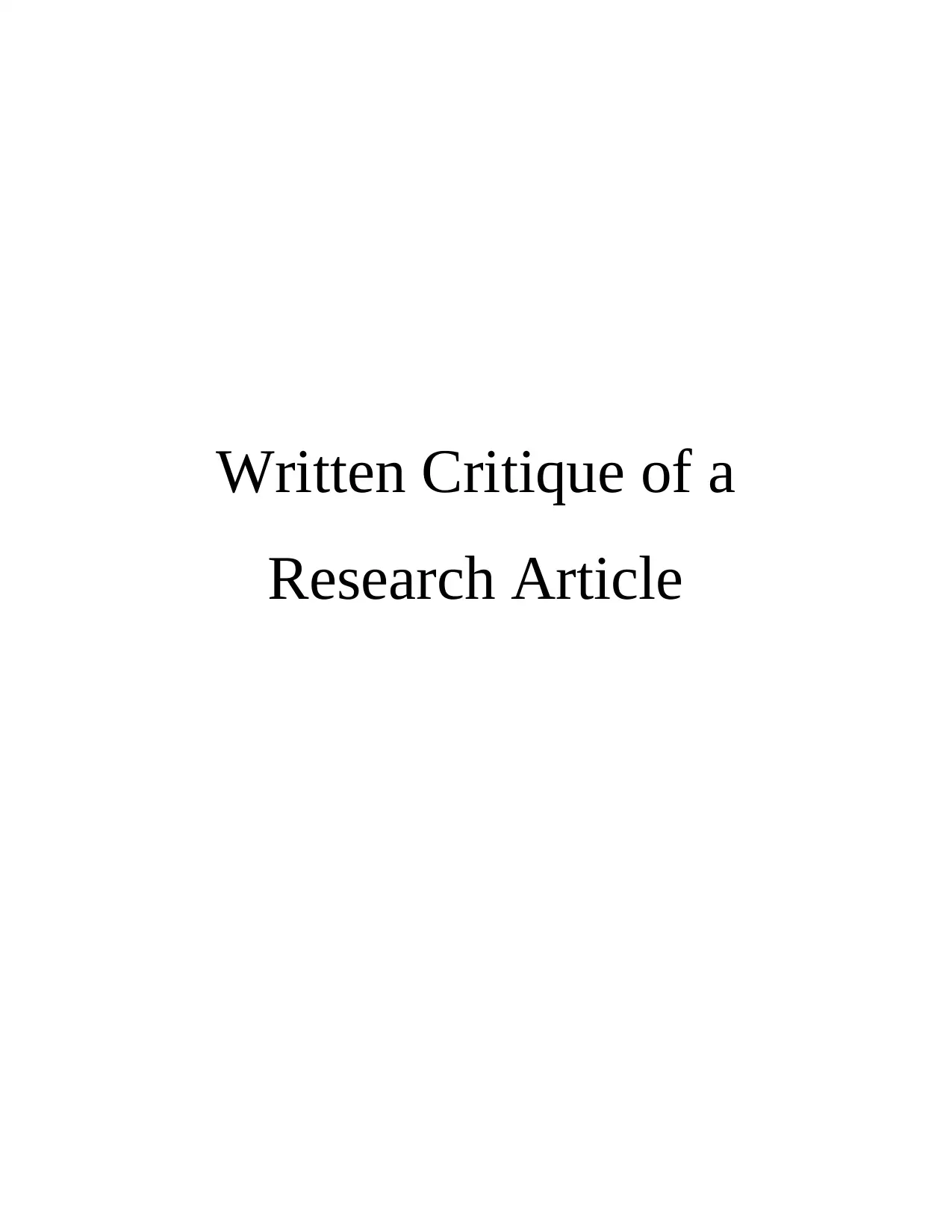
Written Critique of a
Research Article
Research Article
Paraphrase This Document
Need a fresh take? Get an instant paraphrase of this document with our AI Paraphraser
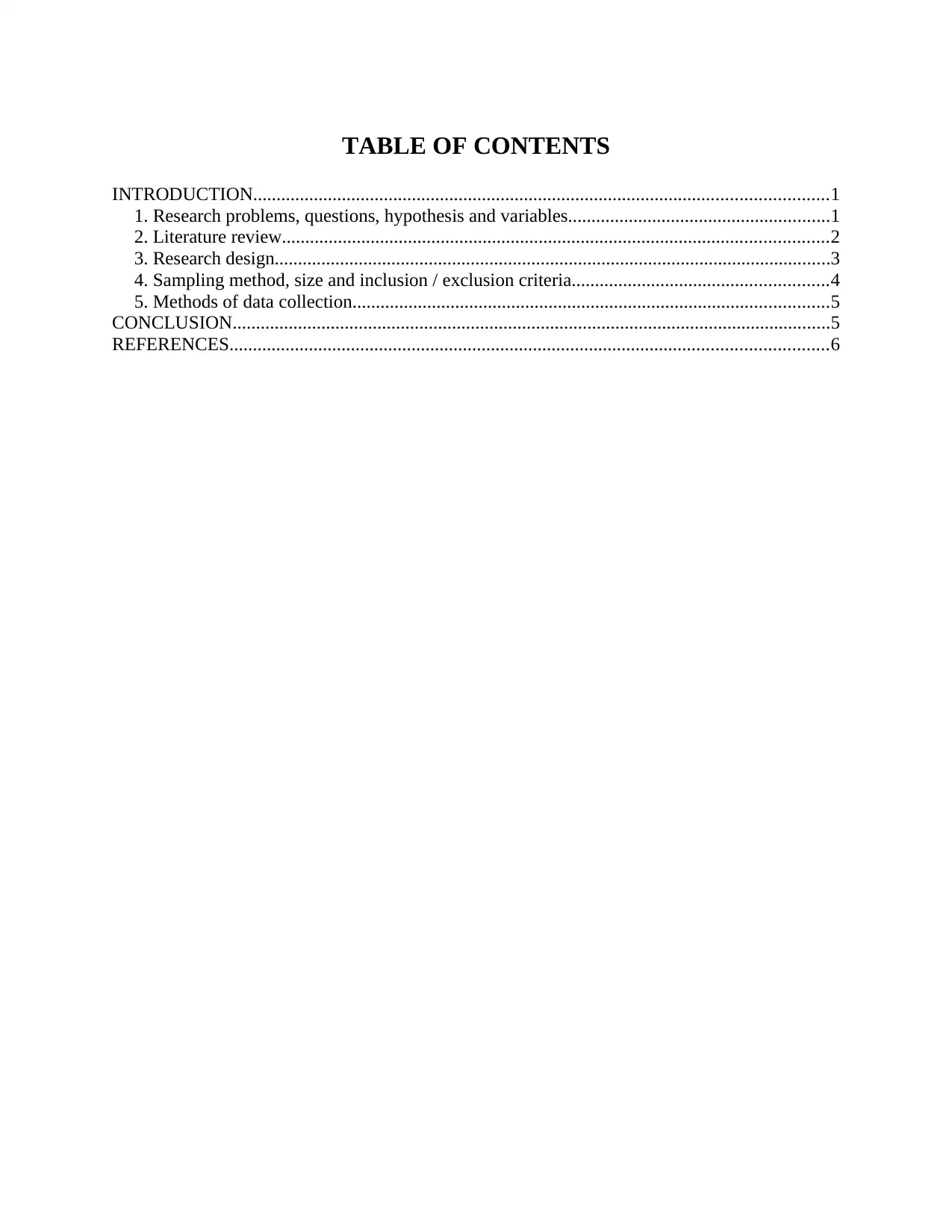
TABLE OF CONTENTS
INTRODUCTION...........................................................................................................................1
1. Research problems, questions, hypothesis and variables........................................................1
2. Literature review.....................................................................................................................2
3. Research design.......................................................................................................................3
4. Sampling method, size and inclusion / exclusion criteria.......................................................4
5. Methods of data collection......................................................................................................5
CONCLUSION................................................................................................................................5
REFERENCES................................................................................................................................6
INTRODUCTION...........................................................................................................................1
1. Research problems, questions, hypothesis and variables........................................................1
2. Literature review.....................................................................................................................2
3. Research design.......................................................................................................................3
4. Sampling method, size and inclusion / exclusion criteria.......................................................4
5. Methods of data collection......................................................................................................5
CONCLUSION................................................................................................................................5
REFERENCES................................................................................................................................6
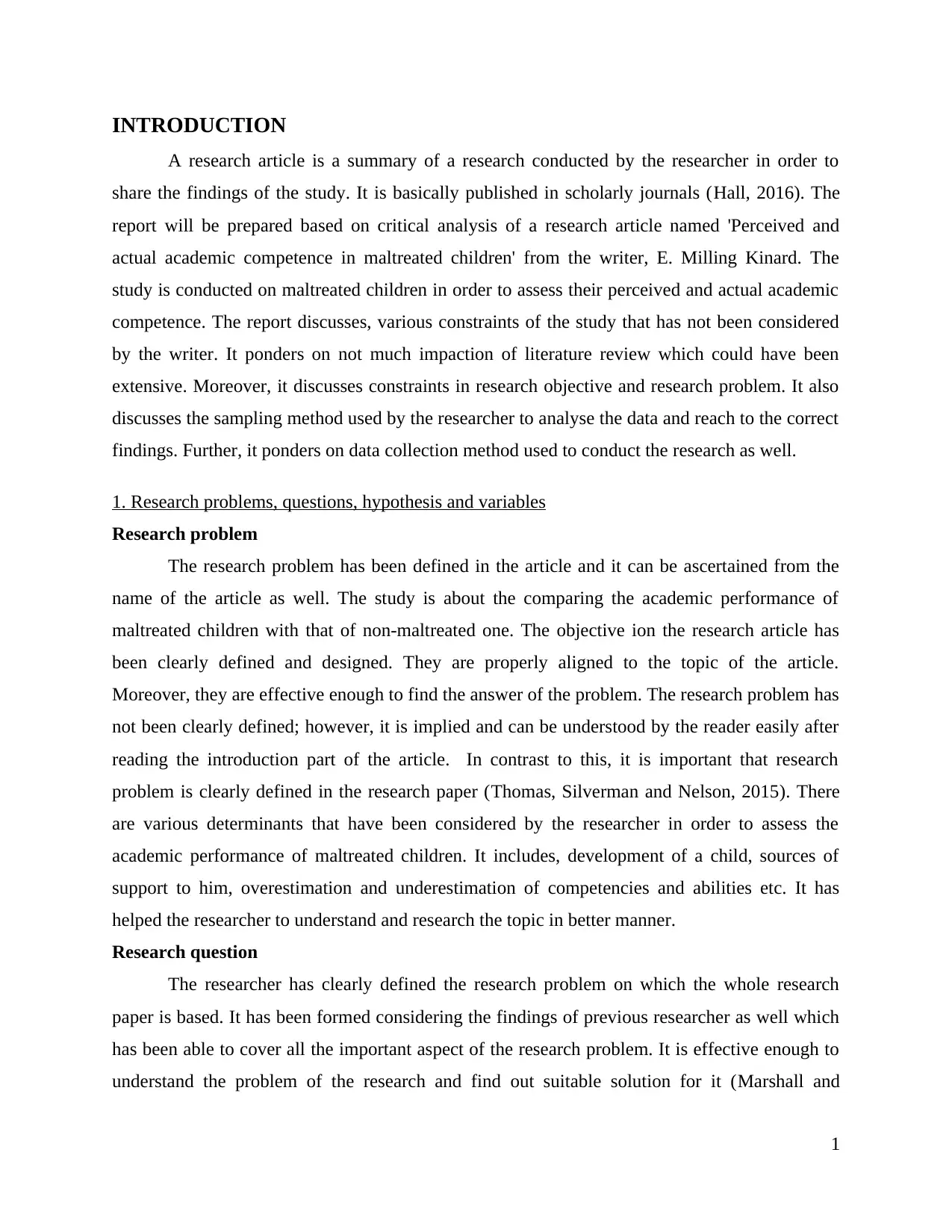
INTRODUCTION
A research article is a summary of a research conducted by the researcher in order to
share the findings of the study. It is basically published in scholarly journals (Hall, 2016). The
report will be prepared based on critical analysis of a research article named 'Perceived and
actual academic competence in maltreated children' from the writer, E. Milling Kinard. The
study is conducted on maltreated children in order to assess their perceived and actual academic
competence. The report discusses, various constraints of the study that has not been considered
by the writer. It ponders on not much impaction of literature review which could have been
extensive. Moreover, it discusses constraints in research objective and research problem. It also
discusses the sampling method used by the researcher to analyse the data and reach to the correct
findings. Further, it ponders on data collection method used to conduct the research as well.
1. Research problems, questions, hypothesis and variables
Research problem
The research problem has been defined in the article and it can be ascertained from the
name of the article as well. The study is about the comparing the academic performance of
maltreated children with that of non-maltreated one. The objective ion the research article has
been clearly defined and designed. They are properly aligned to the topic of the article.
Moreover, they are effective enough to find the answer of the problem. The research problem has
not been clearly defined; however, it is implied and can be understood by the reader easily after
reading the introduction part of the article. In contrast to this, it is important that research
problem is clearly defined in the research paper (Thomas, Silverman and Nelson, 2015). There
are various determinants that have been considered by the researcher in order to assess the
academic performance of maltreated children. It includes, development of a child, sources of
support to him, overestimation and underestimation of competencies and abilities etc. It has
helped the researcher to understand and research the topic in better manner.
Research question
The researcher has clearly defined the research problem on which the whole research
paper is based. It has been formed considering the findings of previous researcher as well which
has been able to cover all the important aspect of the research problem. It is effective enough to
understand the problem of the research and find out suitable solution for it (Marshall and
1
A research article is a summary of a research conducted by the researcher in order to
share the findings of the study. It is basically published in scholarly journals (Hall, 2016). The
report will be prepared based on critical analysis of a research article named 'Perceived and
actual academic competence in maltreated children' from the writer, E. Milling Kinard. The
study is conducted on maltreated children in order to assess their perceived and actual academic
competence. The report discusses, various constraints of the study that has not been considered
by the writer. It ponders on not much impaction of literature review which could have been
extensive. Moreover, it discusses constraints in research objective and research problem. It also
discusses the sampling method used by the researcher to analyse the data and reach to the correct
findings. Further, it ponders on data collection method used to conduct the research as well.
1. Research problems, questions, hypothesis and variables
Research problem
The research problem has been defined in the article and it can be ascertained from the
name of the article as well. The study is about the comparing the academic performance of
maltreated children with that of non-maltreated one. The objective ion the research article has
been clearly defined and designed. They are properly aligned to the topic of the article.
Moreover, they are effective enough to find the answer of the problem. The research problem has
not been clearly defined; however, it is implied and can be understood by the reader easily after
reading the introduction part of the article. In contrast to this, it is important that research
problem is clearly defined in the research paper (Thomas, Silverman and Nelson, 2015). There
are various determinants that have been considered by the researcher in order to assess the
academic performance of maltreated children. It includes, development of a child, sources of
support to him, overestimation and underestimation of competencies and abilities etc. It has
helped the researcher to understand and research the topic in better manner.
Research question
The researcher has clearly defined the research problem on which the whole research
paper is based. It has been formed considering the findings of previous researcher as well which
has been able to cover all the important aspect of the research problem. It is effective enough to
understand the problem of the research and find out suitable solution for it (Marshall and
1
⊘ This is a preview!⊘
Do you want full access?
Subscribe today to unlock all pages.

Trusted by 1+ million students worldwide
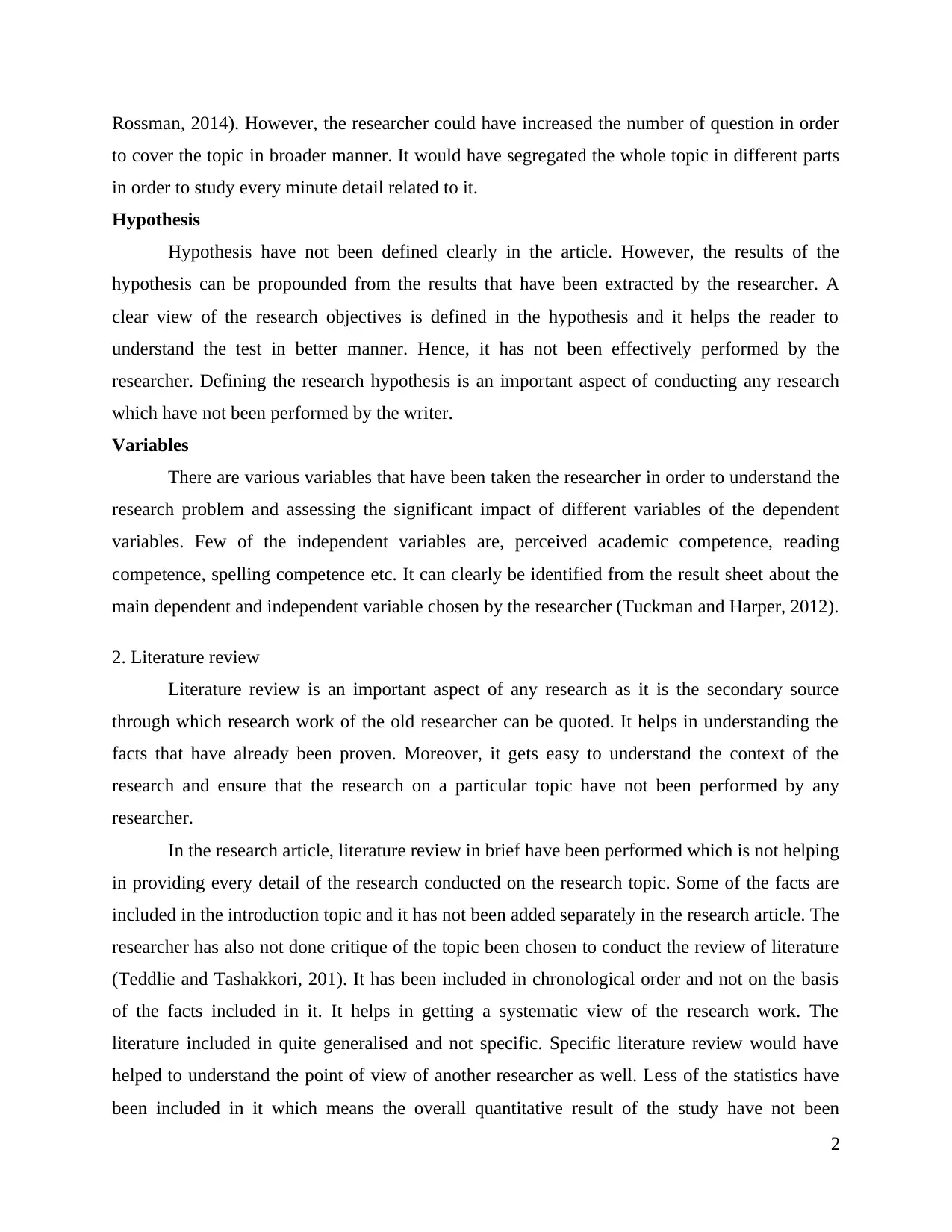
Rossman, 2014). However, the researcher could have increased the number of question in order
to cover the topic in broader manner. It would have segregated the whole topic in different parts
in order to study every minute detail related to it.
Hypothesis
Hypothesis have not been defined clearly in the article. However, the results of the
hypothesis can be propounded from the results that have been extracted by the researcher. A
clear view of the research objectives is defined in the hypothesis and it helps the reader to
understand the test in better manner. Hence, it has not been effectively performed by the
researcher. Defining the research hypothesis is an important aspect of conducting any research
which have not been performed by the writer.
Variables
There are various variables that have been taken the researcher in order to understand the
research problem and assessing the significant impact of different variables of the dependent
variables. Few of the independent variables are, perceived academic competence, reading
competence, spelling competence etc. It can clearly be identified from the result sheet about the
main dependent and independent variable chosen by the researcher (Tuckman and Harper, 2012).
2. Literature review
Literature review is an important aspect of any research as it is the secondary source
through which research work of the old researcher can be quoted. It helps in understanding the
facts that have already been proven. Moreover, it gets easy to understand the context of the
research and ensure that the research on a particular topic have not been performed by any
researcher.
In the research article, literature review in brief have been performed which is not helping
in providing every detail of the research conducted on the research topic. Some of the facts are
included in the introduction topic and it has not been added separately in the research article. The
researcher has also not done critique of the topic been chosen to conduct the review of literature
(Teddlie and Tashakkori, 201). It has been included in chronological order and not on the basis
of the facts included in it. It helps in getting a systematic view of the research work. The
literature included in quite generalised and not specific. Specific literature review would have
helped to understand the point of view of another researcher as well. Less of the statistics have
been included in it which means the overall quantitative result of the study have not been
2
to cover the topic in broader manner. It would have segregated the whole topic in different parts
in order to study every minute detail related to it.
Hypothesis
Hypothesis have not been defined clearly in the article. However, the results of the
hypothesis can be propounded from the results that have been extracted by the researcher. A
clear view of the research objectives is defined in the hypothesis and it helps the reader to
understand the test in better manner. Hence, it has not been effectively performed by the
researcher. Defining the research hypothesis is an important aspect of conducting any research
which have not been performed by the writer.
Variables
There are various variables that have been taken the researcher in order to understand the
research problem and assessing the significant impact of different variables of the dependent
variables. Few of the independent variables are, perceived academic competence, reading
competence, spelling competence etc. It can clearly be identified from the result sheet about the
main dependent and independent variable chosen by the researcher (Tuckman and Harper, 2012).
2. Literature review
Literature review is an important aspect of any research as it is the secondary source
through which research work of the old researcher can be quoted. It helps in understanding the
facts that have already been proven. Moreover, it gets easy to understand the context of the
research and ensure that the research on a particular topic have not been performed by any
researcher.
In the research article, literature review in brief have been performed which is not helping
in providing every detail of the research conducted on the research topic. Some of the facts are
included in the introduction topic and it has not been added separately in the research article. The
researcher has also not done critique of the topic been chosen to conduct the review of literature
(Teddlie and Tashakkori, 201). It has been included in chronological order and not on the basis
of the facts included in it. It helps in getting a systematic view of the research work. The
literature included in quite generalised and not specific. Specific literature review would have
helped to understand the point of view of another researcher as well. Less of the statistics have
been included in it which means the overall quantitative result of the study have not been
2
Paraphrase This Document
Need a fresh take? Get an instant paraphrase of this document with our AI Paraphraser
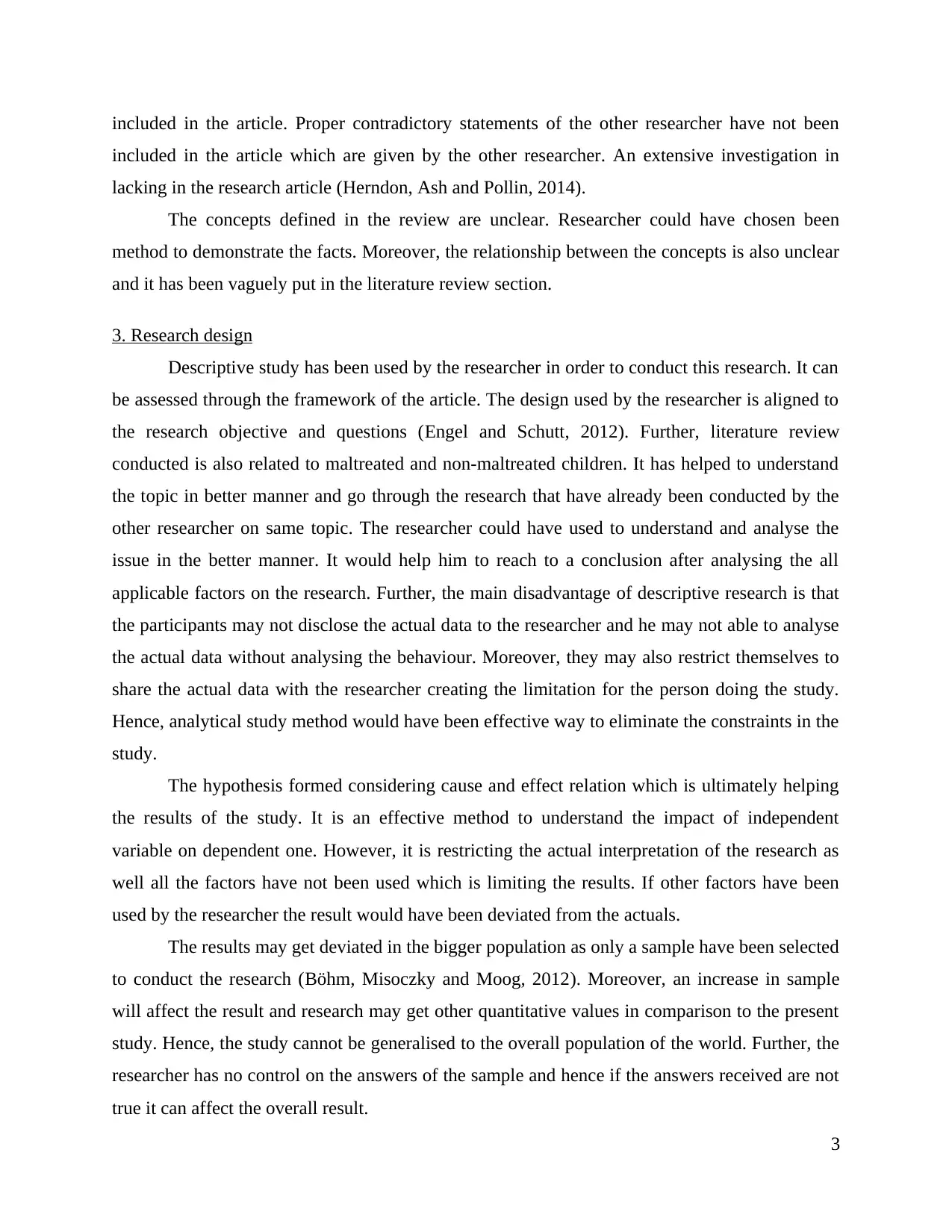
included in the article. Proper contradictory statements of the other researcher have not been
included in the article which are given by the other researcher. An extensive investigation in
lacking in the research article (Herndon, Ash and Pollin, 2014).
The concepts defined in the review are unclear. Researcher could have chosen been
method to demonstrate the facts. Moreover, the relationship between the concepts is also unclear
and it has been vaguely put in the literature review section.
3. Research design
Descriptive study has been used by the researcher in order to conduct this research. It can
be assessed through the framework of the article. The design used by the researcher is aligned to
the research objective and questions (Engel and Schutt, 2012). Further, literature review
conducted is also related to maltreated and non-maltreated children. It has helped to understand
the topic in better manner and go through the research that have already been conducted by the
other researcher on same topic. The researcher could have used to understand and analyse the
issue in the better manner. It would help him to reach to a conclusion after analysing the all
applicable factors on the research. Further, the main disadvantage of descriptive research is that
the participants may not disclose the actual data to the researcher and he may not able to analyse
the actual data without analysing the behaviour. Moreover, they may also restrict themselves to
share the actual data with the researcher creating the limitation for the person doing the study.
Hence, analytical study method would have been effective way to eliminate the constraints in the
study.
The hypothesis formed considering cause and effect relation which is ultimately helping
the results of the study. It is an effective method to understand the impact of independent
variable on dependent one. However, it is restricting the actual interpretation of the research as
well all the factors have not been used which is limiting the results. If other factors have been
used by the researcher the result would have been deviated from the actuals.
The results may get deviated in the bigger population as only a sample have been selected
to conduct the research (Böhm, Misoczky and Moog, 2012). Moreover, an increase in sample
will affect the result and research may get other quantitative values in comparison to the present
study. Hence, the study cannot be generalised to the overall population of the world. Further, the
researcher has no control on the answers of the sample and hence if the answers received are not
true it can affect the overall result.
3
included in the article which are given by the other researcher. An extensive investigation in
lacking in the research article (Herndon, Ash and Pollin, 2014).
The concepts defined in the review are unclear. Researcher could have chosen been
method to demonstrate the facts. Moreover, the relationship between the concepts is also unclear
and it has been vaguely put in the literature review section.
3. Research design
Descriptive study has been used by the researcher in order to conduct this research. It can
be assessed through the framework of the article. The design used by the researcher is aligned to
the research objective and questions (Engel and Schutt, 2012). Further, literature review
conducted is also related to maltreated and non-maltreated children. It has helped to understand
the topic in better manner and go through the research that have already been conducted by the
other researcher on same topic. The researcher could have used to understand and analyse the
issue in the better manner. It would help him to reach to a conclusion after analysing the all
applicable factors on the research. Further, the main disadvantage of descriptive research is that
the participants may not disclose the actual data to the researcher and he may not able to analyse
the actual data without analysing the behaviour. Moreover, they may also restrict themselves to
share the actual data with the researcher creating the limitation for the person doing the study.
Hence, analytical study method would have been effective way to eliminate the constraints in the
study.
The hypothesis formed considering cause and effect relation which is ultimately helping
the results of the study. It is an effective method to understand the impact of independent
variable on dependent one. However, it is restricting the actual interpretation of the research as
well all the factors have not been used which is limiting the results. If other factors have been
used by the researcher the result would have been deviated from the actuals.
The results may get deviated in the bigger population as only a sample have been selected
to conduct the research (Böhm, Misoczky and Moog, 2012). Moreover, an increase in sample
will affect the result and research may get other quantitative values in comparison to the present
study. Hence, the study cannot be generalised to the overall population of the world. Further, the
researcher has no control on the answers of the sample and hence if the answers received are not
true it can affect the overall result.
3
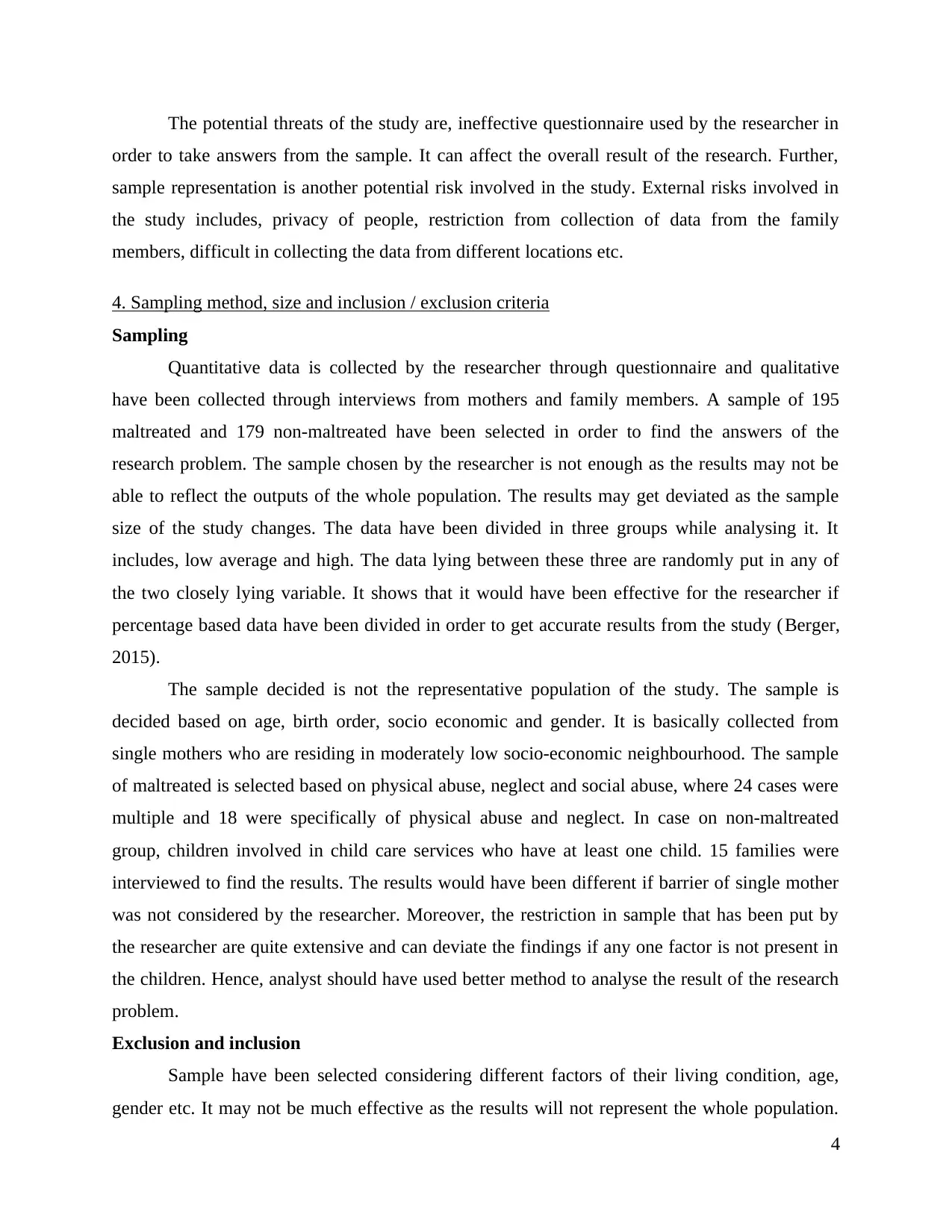
The potential threats of the study are, ineffective questionnaire used by the researcher in
order to take answers from the sample. It can affect the overall result of the research. Further,
sample representation is another potential risk involved in the study. External risks involved in
the study includes, privacy of people, restriction from collection of data from the family
members, difficult in collecting the data from different locations etc.
4. Sampling method, size and inclusion / exclusion criteria
Sampling
Quantitative data is collected by the researcher through questionnaire and qualitative
have been collected through interviews from mothers and family members. A sample of 195
maltreated and 179 non-maltreated have been selected in order to find the answers of the
research problem. The sample chosen by the researcher is not enough as the results may not be
able to reflect the outputs of the whole population. The results may get deviated as the sample
size of the study changes. The data have been divided in three groups while analysing it. It
includes, low average and high. The data lying between these three are randomly put in any of
the two closely lying variable. It shows that it would have been effective for the researcher if
percentage based data have been divided in order to get accurate results from the study (Berger,
2015).
The sample decided is not the representative population of the study. The sample is
decided based on age, birth order, socio economic and gender. It is basically collected from
single mothers who are residing in moderately low socio-economic neighbourhood. The sample
of maltreated is selected based on physical abuse, neglect and social abuse, where 24 cases were
multiple and 18 were specifically of physical abuse and neglect. In case on non-maltreated
group, children involved in child care services who have at least one child. 15 families were
interviewed to find the results. The results would have been different if barrier of single mother
was not considered by the researcher. Moreover, the restriction in sample that has been put by
the researcher are quite extensive and can deviate the findings if any one factor is not present in
the children. Hence, analyst should have used better method to analyse the result of the research
problem.
Exclusion and inclusion
Sample have been selected considering different factors of their living condition, age,
gender etc. It may not be much effective as the results will not represent the whole population.
4
order to take answers from the sample. It can affect the overall result of the research. Further,
sample representation is another potential risk involved in the study. External risks involved in
the study includes, privacy of people, restriction from collection of data from the family
members, difficult in collecting the data from different locations etc.
4. Sampling method, size and inclusion / exclusion criteria
Sampling
Quantitative data is collected by the researcher through questionnaire and qualitative
have been collected through interviews from mothers and family members. A sample of 195
maltreated and 179 non-maltreated have been selected in order to find the answers of the
research problem. The sample chosen by the researcher is not enough as the results may not be
able to reflect the outputs of the whole population. The results may get deviated as the sample
size of the study changes. The data have been divided in three groups while analysing it. It
includes, low average and high. The data lying between these three are randomly put in any of
the two closely lying variable. It shows that it would have been effective for the researcher if
percentage based data have been divided in order to get accurate results from the study (Berger,
2015).
The sample decided is not the representative population of the study. The sample is
decided based on age, birth order, socio economic and gender. It is basically collected from
single mothers who are residing in moderately low socio-economic neighbourhood. The sample
of maltreated is selected based on physical abuse, neglect and social abuse, where 24 cases were
multiple and 18 were specifically of physical abuse and neglect. In case on non-maltreated
group, children involved in child care services who have at least one child. 15 families were
interviewed to find the results. The results would have been different if barrier of single mother
was not considered by the researcher. Moreover, the restriction in sample that has been put by
the researcher are quite extensive and can deviate the findings if any one factor is not present in
the children. Hence, analyst should have used better method to analyse the result of the research
problem.
Exclusion and inclusion
Sample have been selected considering different factors of their living condition, age,
gender etc. It may not be much effective as the results will not represent the whole population.
4
⊘ This is a preview!⊘
Do you want full access?
Subscribe today to unlock all pages.

Trusted by 1+ million students worldwide
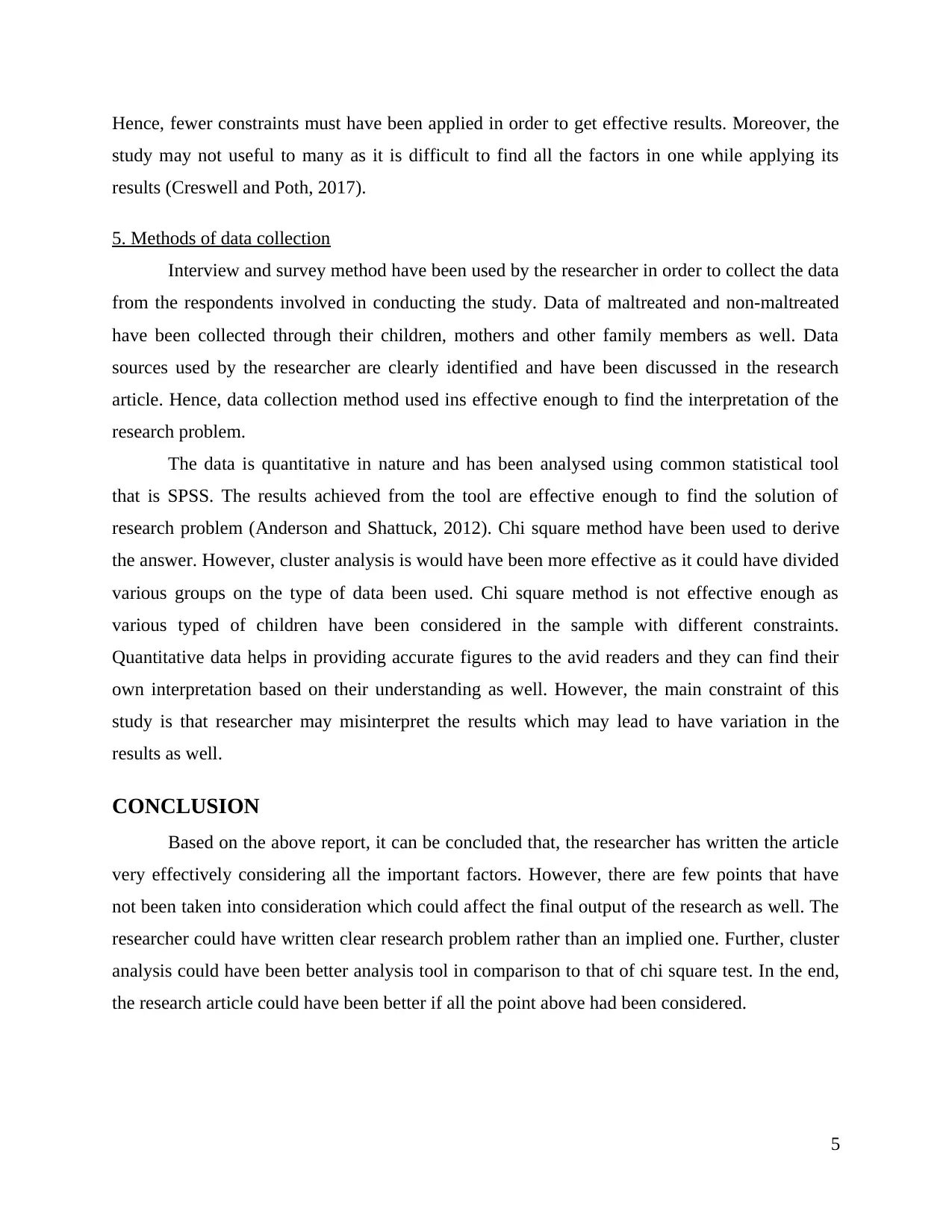
Hence, fewer constraints must have been applied in order to get effective results. Moreover, the
study may not useful to many as it is difficult to find all the factors in one while applying its
results (Creswell and Poth, 2017).
5. Methods of data collection
Interview and survey method have been used by the researcher in order to collect the data
from the respondents involved in conducting the study. Data of maltreated and non-maltreated
have been collected through their children, mothers and other family members as well. Data
sources used by the researcher are clearly identified and have been discussed in the research
article. Hence, data collection method used ins effective enough to find the interpretation of the
research problem.
The data is quantitative in nature and has been analysed using common statistical tool
that is SPSS. The results achieved from the tool are effective enough to find the solution of
research problem (Anderson and Shattuck, 2012). Chi square method have been used to derive
the answer. However, cluster analysis is would have been more effective as it could have divided
various groups on the type of data been used. Chi square method is not effective enough as
various typed of children have been considered in the sample with different constraints.
Quantitative data helps in providing accurate figures to the avid readers and they can find their
own interpretation based on their understanding as well. However, the main constraint of this
study is that researcher may misinterpret the results which may lead to have variation in the
results as well.
CONCLUSION
Based on the above report, it can be concluded that, the researcher has written the article
very effectively considering all the important factors. However, there are few points that have
not been taken into consideration which could affect the final output of the research as well. The
researcher could have written clear research problem rather than an implied one. Further, cluster
analysis could have been better analysis tool in comparison to that of chi square test. In the end,
the research article could have been better if all the point above had been considered.
5
study may not useful to many as it is difficult to find all the factors in one while applying its
results (Creswell and Poth, 2017).
5. Methods of data collection
Interview and survey method have been used by the researcher in order to collect the data
from the respondents involved in conducting the study. Data of maltreated and non-maltreated
have been collected through their children, mothers and other family members as well. Data
sources used by the researcher are clearly identified and have been discussed in the research
article. Hence, data collection method used ins effective enough to find the interpretation of the
research problem.
The data is quantitative in nature and has been analysed using common statistical tool
that is SPSS. The results achieved from the tool are effective enough to find the solution of
research problem (Anderson and Shattuck, 2012). Chi square method have been used to derive
the answer. However, cluster analysis is would have been more effective as it could have divided
various groups on the type of data been used. Chi square method is not effective enough as
various typed of children have been considered in the sample with different constraints.
Quantitative data helps in providing accurate figures to the avid readers and they can find their
own interpretation based on their understanding as well. However, the main constraint of this
study is that researcher may misinterpret the results which may lead to have variation in the
results as well.
CONCLUSION
Based on the above report, it can be concluded that, the researcher has written the article
very effectively considering all the important factors. However, there are few points that have
not been taken into consideration which could affect the final output of the research as well. The
researcher could have written clear research problem rather than an implied one. Further, cluster
analysis could have been better analysis tool in comparison to that of chi square test. In the end,
the research article could have been better if all the point above had been considered.
5
Paraphrase This Document
Need a fresh take? Get an instant paraphrase of this document with our AI Paraphraser
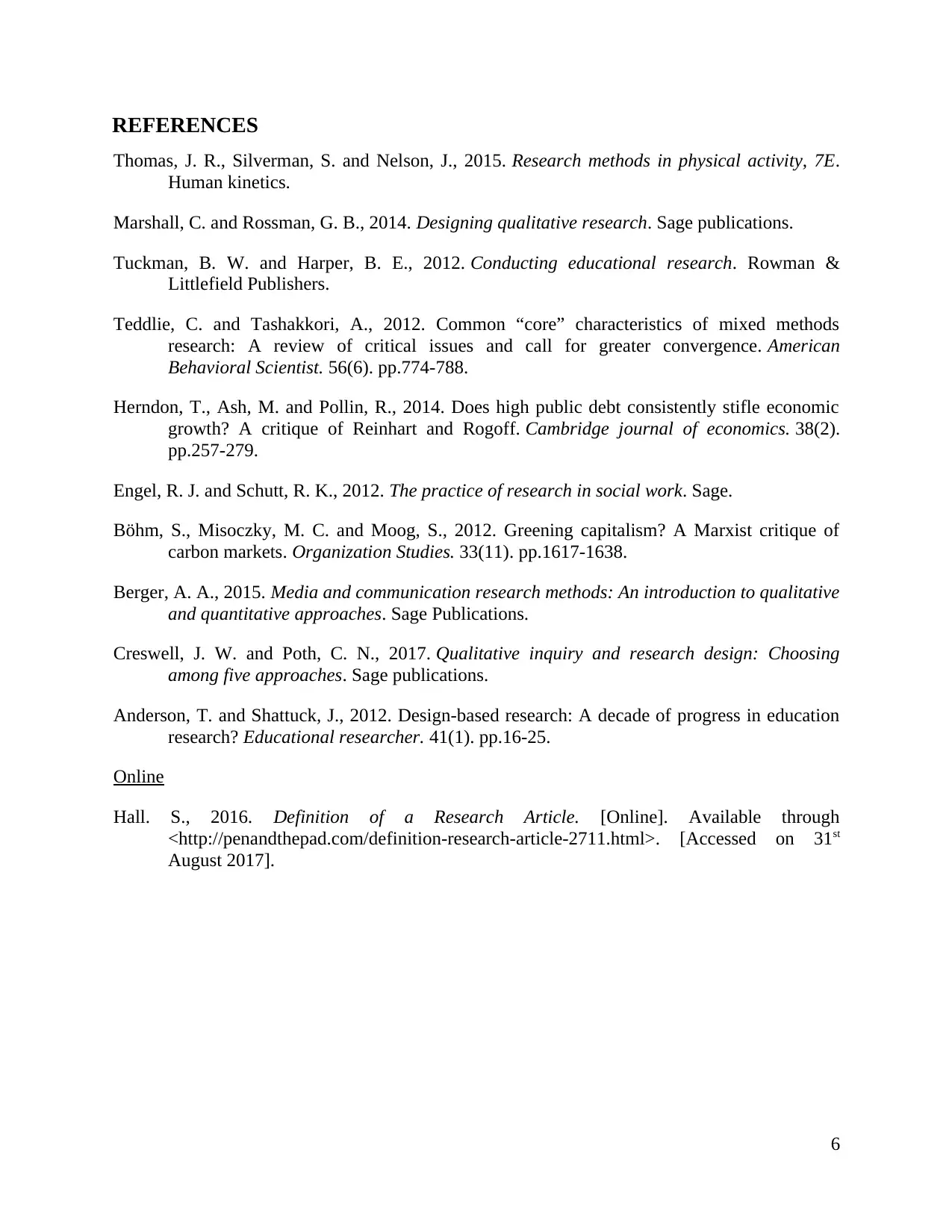
REFERENCES
Thomas, J. R., Silverman, S. and Nelson, J., 2015. Research methods in physical activity, 7E.
Human kinetics.
Marshall, C. and Rossman, G. B., 2014. Designing qualitative research. Sage publications.
Tuckman, B. W. and Harper, B. E., 2012. Conducting educational research. Rowman &
Littlefield Publishers.
Teddlie, C. and Tashakkori, A., 2012. Common “core” characteristics of mixed methods
research: A review of critical issues and call for greater convergence. American
Behavioral Scientist. 56(6). pp.774-788.
Herndon, T., Ash, M. and Pollin, R., 2014. Does high public debt consistently stifle economic
growth? A critique of Reinhart and Rogoff. Cambridge journal of economics. 38(2).
pp.257-279.
Engel, R. J. and Schutt, R. K., 2012. The practice of research in social work. Sage.
Böhm, S., Misoczky, M. C. and Moog, S., 2012. Greening capitalism? A Marxist critique of
carbon markets. Organization Studies. 33(11). pp.1617-1638.
Berger, A. A., 2015. Media and communication research methods: An introduction to qualitative
and quantitative approaches. Sage Publications.
Creswell, J. W. and Poth, C. N., 2017. Qualitative inquiry and research design: Choosing
among five approaches. Sage publications.
Anderson, T. and Shattuck, J., 2012. Design-based research: A decade of progress in education
research? Educational researcher. 41(1). pp.16-25.
Online
Hall. S., 2016. Definition of a Research Article. [Online]. Available through
<http://penandthepad.com/definition-research-article-2711.html>. [Accessed on 31st
August 2017].
6
Thomas, J. R., Silverman, S. and Nelson, J., 2015. Research methods in physical activity, 7E.
Human kinetics.
Marshall, C. and Rossman, G. B., 2014. Designing qualitative research. Sage publications.
Tuckman, B. W. and Harper, B. E., 2012. Conducting educational research. Rowman &
Littlefield Publishers.
Teddlie, C. and Tashakkori, A., 2012. Common “core” characteristics of mixed methods
research: A review of critical issues and call for greater convergence. American
Behavioral Scientist. 56(6). pp.774-788.
Herndon, T., Ash, M. and Pollin, R., 2014. Does high public debt consistently stifle economic
growth? A critique of Reinhart and Rogoff. Cambridge journal of economics. 38(2).
pp.257-279.
Engel, R. J. and Schutt, R. K., 2012. The practice of research in social work. Sage.
Böhm, S., Misoczky, M. C. and Moog, S., 2012. Greening capitalism? A Marxist critique of
carbon markets. Organization Studies. 33(11). pp.1617-1638.
Berger, A. A., 2015. Media and communication research methods: An introduction to qualitative
and quantitative approaches. Sage Publications.
Creswell, J. W. and Poth, C. N., 2017. Qualitative inquiry and research design: Choosing
among five approaches. Sage publications.
Anderson, T. and Shattuck, J., 2012. Design-based research: A decade of progress in education
research? Educational researcher. 41(1). pp.16-25.
Online
Hall. S., 2016. Definition of a Research Article. [Online]. Available through
<http://penandthepad.com/definition-research-article-2711.html>. [Accessed on 31st
August 2017].
6
1 out of 8
Related Documents
Your All-in-One AI-Powered Toolkit for Academic Success.
+13062052269
info@desklib.com
Available 24*7 on WhatsApp / Email
![[object Object]](/_next/static/media/star-bottom.7253800d.svg)
Unlock your academic potential
Copyright © 2020–2025 A2Z Services. All Rights Reserved. Developed and managed by ZUCOL.





